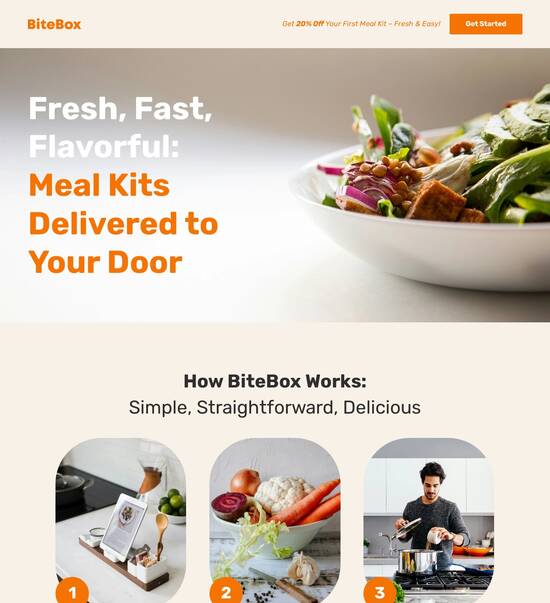
Website template for domestic violence shelters
Explore Similar TemplatesAbout template
Jumpstart your website with our polished, ready-to-go template for domestic violence shelters.
Recommended templates

Easy to build without coding
With the intuitive drag-and-drop builder, anyone on your team can create high-converting pages without any knowledge of code or design. Make enhancements to your landing page with custom widgets using Javascript, HTML/CSS, or third-party scripts.

Multiple layouts for any industry and goal
Select from 500+ landing page layouts built to boost conversions across industry-specific scenarios. Customize them by adjusting fonts, adding images, and generating on-brand content with the AI assistant. Quickly scale with Instablocks® and Global Blocks that you can save, reuse, and update globally.

Loads fast and looks polished on any device
Every template is responsive, which means they present professionally on any device and load blazingly fast with our Thor Render Engine. You can also power them up with Google AMP technology to deliver an unparalleled mobile experience and drive higher conversions.

Robust analytics & experimentation
Get real-time updates and reporting across all your devices, showing the number of visitors, conversions, cost-per-visitor, and cost-per-lead. Launch AI-powered experiments, run A/B tests, and use heatmaps to analyze user behavior, then optimize your landing page to maximize conversions.







Easy to build without coding
With the intuitive drag-and-drop builder, anyone on your team can create high-converting pages without any knowledge of code or design. Make enhancements to your landing page with custom widgets using Javascript, HTML/CSS, or third-party scripts.
Multiple layouts for any industry and goal
Select from 500+ landing page layouts built to boost conversions across industry-specific scenarios. Customize them by adjusting fonts, adding images, and generating on-brand content with the AI assistant. Quickly scale with Instablocks® and Global Blocks that you can save, reuse, and update globally.
Loads fast and looks polished on any device
Every template is responsive, which means they present professionally on any device and load blazingly fast with our Thor Render Engine.
Robust analytics & experimentation
Get real-time updates and reporting across all your devices, showing the number of visitors, conversions, cost-per-visitor, and cost-per-lead. Launch AI-powered experiments, run A/B tests, and use heatmaps to analyze user behavior, then optimize your landing page to maximize conversions.
All the features you need to build lead-generating landing pages
Explore more featuresLearn how to build top-performing landing pages for any goal
FAQs
Leading the way in building high-performing landing pages





Create impactful landing pages with Instapage for domestic violence shelters
Instapage provides formidable templates specifically designed for domestic violence shelters looking to enhance their outreach. With over 100 high-converting templates, you can quickly customize landing pages that resonate with your audience. This is crucial in attracting the necessary support and resources for victims of domestic violence.
Understanding the needs of domestic violence shelters
Effective communication is key for shelters to connect with their community and potential donors. Recognizing the unique challenges shelters face, Instapage’s designs focus on compassion and urgency, ensuring that the message reaches those in need. Leveraging the strength of intuitive page-building tools, shelters can create compelling stories that drive engagement.
- User-friendly templates: Built for quick customization, these templates allow shelters to convey critical information without requiring technical skills.
- Access to analytics: Install tracking to monitor visits and understand how users interact with the pages, facilitating continued optimization.
- Integration capabilities: Link with donation platforms and support services directly from the landing pages, simplifying resource accessibility.
Step 1: Choose the right template
Start by selecting a suitable template from Instapage's library designed for social causes. Focus on layouts that provide clarity and direct calls to action.
Step 2: Customize with compelling content
Your message should focus on personal stories and urgent calls to action to encourage donations and support.
- Emphasize testimonials: Real stories from survivors can humanize your message and create a deeper emotional connection.
- Highlight urgency: Clearly state how support can make an immediate impact on a victim’s life.
- Utilize visuals: Include images that resonate with your mission, fostering a sense of community and shared understanding.
Step 3: Optimize for conversions
Utilize A/B testing to compare elements like headlines and calls to action. Analyze your heatmaps to see how users interact with your page.
- Implement call-to-action buttons: Ensure every section has a clear and clickable CTA.
- Conduct A/B testing: Experiment with different designs and messages to see what yields the best response.
- Monitor analytics: Regularly review performance metrics to identify opportunities for enhancing user engagement.
By following these steps, domestic violence shelters can effectively harness the power of Instapage to connect with their audience and drive meaningful action.
Explore Instapage to transform your landing pages today—create a stronger connection, maximize your outreach, and ultimately, support more victims in need.
Website templates for domestic violence shelters: A comprehensive guide
Understanding the need for custom website templates for domestic violence shelters
Domestic violence shelters play a crucial role in providing assistance to individuals and families affected by abuse. However, many shelters struggle with their online presence, which is essential in reaching out to those in need. A cohesive and functional website can serve as a vital lifeline, offering necessary information and support. Understanding the specific requirements for domestic violence shelters is foundational when developing a robust online platform.
Prevalence of domestic violence requires a strong online outreach.
Online access to resources can be a crucial first step for victims.
A well-designed website can foster trust and increase user engagement.
The importance of online presence for domestic violence shelters
The significance of a strong online presence cannot be overstated for domestic violence shelters. Statistics reveal that approximately one in four women and one in nine men experience severe intimate partner physical violence. These alarming figures highlight the urgent need for shelters to be accessible to those in distress. A well-organized website can function as an immediate source of support, allowing individuals to access essential information discreetly.
Digital accessibility is crucial, as many victims may feel uncomfortable or unsafe seeking help in person. A properly constructed website offers them a confidential way to explore options and resources. Additionally, an aesthetically pleasing and user-friendly site can significantly impact how potential users perceive the shelter's services. A warm, welcoming design can help ease the anxiety of individuals seeking help.
Key features of an effective website template
Creating a website template specifically for domestic violence shelters involves several key features aimed at enhancing user experience. User-friendly navigation should be a priority, facilitating easy access to critical resources. An intuitive layout encourages visitors to find emergency contacts, counseling information, and support services without frustration.
Mobile responsiveness is another vital element. With many users accessing websites through smartphones, especially in urgent situations, templates must adapt accordingly. Moreover, adhering to accessibility standards such as the Americans with Disabilities Act (ADA) ensures that individuals with disabilities can also navigate the site effectively.
User-friendly navigation for easy access to services.
Mobile responsiveness to cater to users on different devices.
Compliance with accessibility standards for inclusiveness.
Customizable sections tailored for shelters
A well-structured website template should offer customizable sections that cater specifically to the unique needs of domestic violence shelters. Dedicated emergency resource pages are essential. These pages can clearly outline immediate assistance options and list local resources to ensure users can find help quickly. This structure allows shelters to present vital information at the forefront, making it easy for users to locate exactly what they need.
Support group information is another critical component. Highlighting session times, locations, and contact details allows users to plan participation conveniently. Additionally, including educational content forms a crucial part of the template. Articles, FAQs, and resources about domestic violence raise awareness and provide users with helpful advice on navigating their situations.
Emergency resource pages for immediate assistance.
Information on support groups, aiding user convenience.
Educational content to empower victims and inform them.
Innovative functionalities to enhance user experience
Incorporating innovative functionalities into a website template can significantly enhance the user experience for victims of domestic violence. Integrated crisis chat options allow individuals to receive real-time assistance from trained counselors. Such features can be life-saving, as they offer users a way to communicate discreetly and safely.
Ensuring anonymity and safety in these communication channels is paramount. Users must feel secure that their identities are protected while seeking help. Events such as workshops or support sessions can also be streamlined through interactive calendars within the website. This feature enables users to view upcoming events and register effortlessly, increasing the likelihood of participation in healing activities.
Crisis chat options for direct, real-time assistance.
Anonymous communication channels to protect user identities.
Interactive calendars for event scheduling and registration.
Optimizing for search engines and user engagement
Search engine optimization (SEO) is vital for increasing visibility and engagement for domestic violence shelters. A strategic approach to SEO includes identifying keywords relevant to the services provided. Knowing what potential users might search for enables shelters to create targeted content that addresses their needs. Utilizing local keywords can also drive traffic from individuals seeking immediate support.
Crafting compelling meta descriptions and tags is essential for attracting clicks. These descriptions should succinctly convey what assistance is available to potential users. A user-friendly content management system (CMS) should also be integrated, allowing shelter staff to easily update information, ensuring resources remain current. Furthermore, incorporating a blog into the website can facilitate ongoing engagement through relevant articles and updates on domestic violence issues.
Identifying relevant keywords for improved visibility.
Using effective meta descriptions and tags to drive traffic.
CMS for easy updates and blog integration for continuous engagement.
Building trust through design and content
Design plays a pivotal role in conveying safety and trust on domestic violence shelter websites. Visual elements should be chosen to create a soothing atmosphere that encourages users to engage. Comforting colors, calming images, and appropriate typography can contribute to a welcoming online environment where users feel secure seeking help.
In addition to design elements, sharing survivor testimonies can build trust. Real stories of hope and empowerment resonate with those in distress, demonstrating the potential for recovery and support offered by the shelter. This authentic content can foster a sense of community and assurance for newcomers who may feel apprehensive.
Visual elements that promote a soothing and secure atmosphere.
Survivor testimonials to instill trust in the shelter’s support.
A sense of community fostered through shared stories.
The role of Family Transition Place in template design
Family Transition Place is an exemplary model of how tailored website templates can effectively serve the unique needs of families facing domestic violence. The design includes specific features aimed at children and teens, addressing their emotional and psychological needs. This targeted approach allows shelters to communicate with younger audiences, ensuring that they too feel welcomed and understood.
Moreover, Family Transition Place collaborates with local health services to provide users with comprehensive support. By integrating local resource directories, shelters can facilitate access to health services, counseling, and long-term assistance, creating a holistic support network. This collaboration can ultimately enhance the effectiveness of the shelter’s outreach efforts.
Addressing unique needs of families with targeted resources.
Engaging younger audiences with specialized content.
Local health service integrations for holistic support assistance.
Measuring impact and effectiveness
To ensure that a website template fulfills its intended purpose, measuring impact and effectiveness is essential. Utilizing analytics and user tracking tools allows shelters to understand visitor behavior and the resources most frequently accessed. This data can provide valuable insights into the needs of users and help tailor services based on actual usage patterns.
Establishing key performance indicators (KPIs) can also help shelters evaluate success in converting website visitors into users of their services. Additionally, incorporating user feedback mechanisms, such as simple surveys, fosters a culture of continuous improvement. This iterative design process allows shelters to adapt their websites based on real user experiences and adapt their services to better serve those in need.
Utilizing analytics for understanding visitor behavior.
Setting KPIs to measure website effectiveness.
Continuous improvement through user feedback mechanisms.
Challenges and considerations in implementation
While developing a website template for domestic violence shelters, challenges may arise, particularly concerning budget constraints. Many shelters operate with limited resources, making cost-effective solutions vital. Exploring affordable website template options without compromising functionality can help shelters create online spaces that serve their communities efficiently.
Additionally, leveraging grants and donations for funding can facilitate website development or upgrades. Engaging with local businesses or community organizations may provide the financial support necessary for creating modern, responsive sites that can better serve the needs of victims. Ensuring confidentiality and security is another critical consideration; best practices must be established to safeguard user data.
Exploring cost-effective solutions amidst budget constraints.
Seeking grants and donations for website funding.
Implementing privacy protocols to safeguard user data.
Ready to skyrocket conversions?
Supercharge your ad campaigns with high-performing landing pages
Get started














